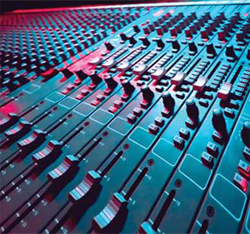
The spirit of “we’re here to help” and “what part can I play to take the load off of you?” was highly welcome, and in my case, much needed, as I had not mixed on some of the consoles before.
But the ability of those who offered their assistance was perhaps even more welcome than their willingness. I got a quick lesson on an Avid VENUE SC48, along with assistance on routing and effect selection, that greatly helped to make that night’s show a rousing success. I was coached on a Yamaha M7CL, and it didn’t take long to get a grasp on how it differs from the PM5D. I got some help on a Midas 3000.
Even though analog’s my thing, and I’ve used most popular consoles before, it’s difficult to remember all the ins and outs when you’re not doing this work every day. The impressions of consoles I came away with: I greatly respect the power of digital consoles to make life far better in many ways, especially when there are multiple acts sharing the same desk.
The digital desks that I used sounded fine, though I’ll admit to liking the sound of the Midas better (and I recognize there was no way to directly compare it in any meaningful way). Behavior-wise, some digital control schemes are easier to work with than others, at least when you’re not acquainted with the architecture of the console and how to bend it to your needs.
It’s an exciting time to be in the middle of a true technology transition. The best is surely yet to come. But while we’re waiting for the future to manifest itself, let’s look at the wide range of ways that a console is used, using two polar opposites as examples.
Set It & Forget It Mix
A lot of mix engineers, working a lot of shows, approach the mix from the basis of getting all of the microphones and other inputs up and running at the proper gain settings, establishing an acceptable balance, and then letting the artist create the dynamics.
If the artist has adequate stage monitoring; if the sonic energy coming off the stage is not great enough to play much of a role in the house mix; if the artist knows how to regulate their own dynamic range; and if (by some miracle) the artist can detect the level of ambient audience noise in the venue (or if audience noise is not an issue), then such an approach can thrive, or at least work very well.
Corporate, TV, symphonic, most jazz, and other genres may successfully be addressed in this way. In such cases, the use of layers in a digital mixing console pose no impediment to achieving the best possible results.
Producer Mix
Conversely, there are many good reasons to ride the mix from moment-to-moment, such as: changes in vocal levels as the performers alter their delivery throughout a performance; adjustments to stage amps – especially if the sonic output from the MI amplifiers is playing a big role in the venue (as in smaller spaces or very loud stage amps); changes in audience ambient noise; lack of uniformity in physical attack on a drum kit; changes in monitor levels; and numerous other factors all point to the need to ride the mix as tightly as if you’re steering a big rig down I-395 in a thundershower.
A music-sensitive house engineer can add some serious dynamics to a show, once he/she understands the music and the intent of the artist. The result can well transcend even the best that might have been captured in the studio for the album recording. This is where live sound really comes into its own.
